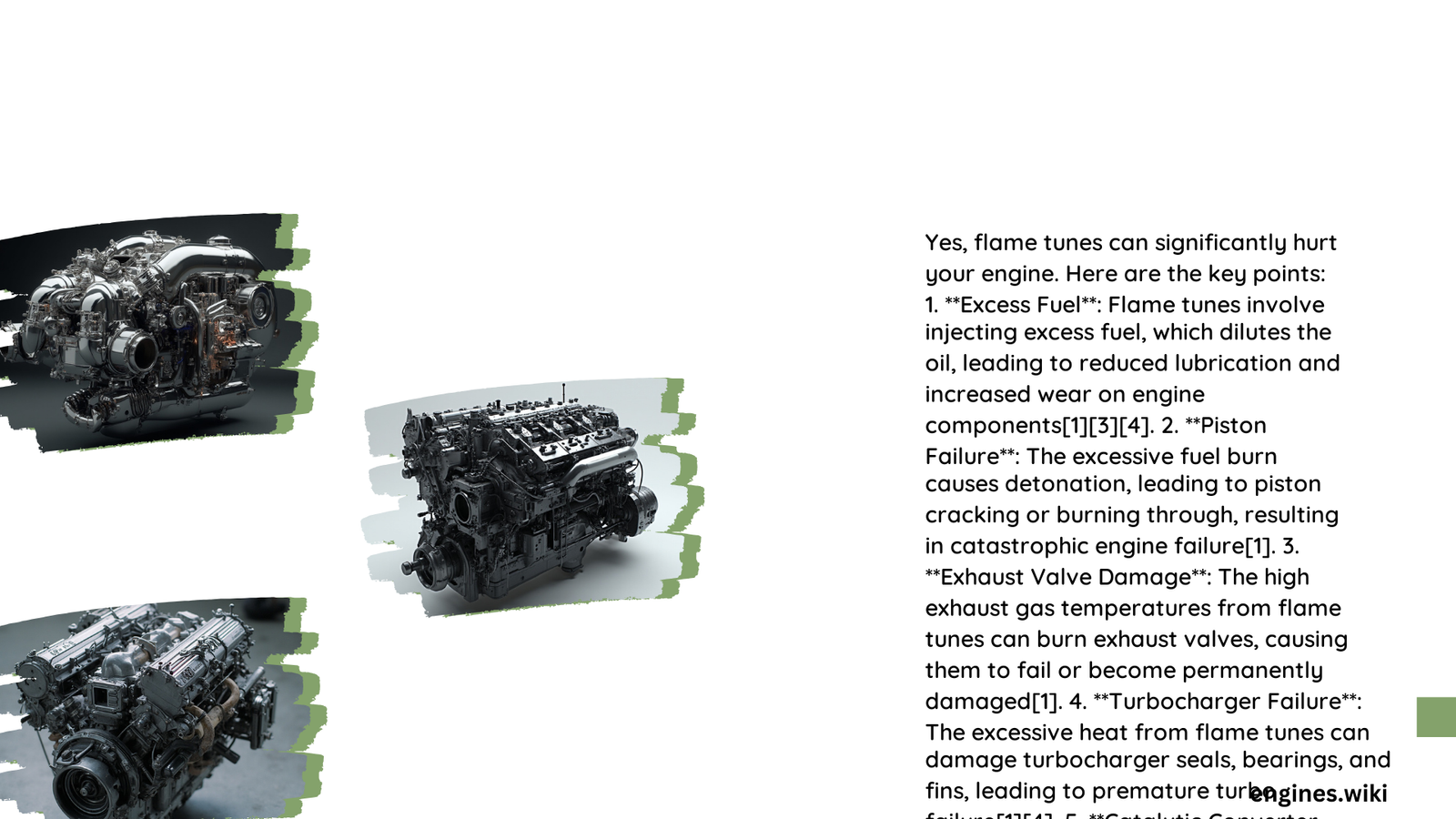Flame tunes, while visually spectacular, can indeed hurt your engine. These modifications, designed to produce dramatic flames from the exhaust, often involve running rich fuel mixtures and altering ignition timing. This practice can lead to significant engine wear, reduced performance, and potential damage to various components. The risks include premature wear on pistons, cylinders, and valves, as well as damage to the exhaust system and turbochargers. While the allure of shooting flames may be tempting, the long-term consequences on engine health and performance are substantial.
What Are the Risks of Flame Tunes to Engine Components?
Flame tunes can pose serious risks to various engine components:
Pistons and Cylinders
- Bore Wash: The rich fuel mixture can strip oil from cylinder walls, leading to:
- Increased friction
- Premature wear
- Potential scoring of cylinder walls
Valves
- Heat Damage: Unburnt fuel igniting in the exhaust can cause:
- Excessive heat on exhaust valves
- Warping or cracking of valve stems
- Backfire Stress: Rich mixtures during deceleration can lead to:
- Backfires in the combustion chamber
- Increased stress on intake and exhaust valves
Exhaust System
- Muffler Damage: Ignition of fuel in the exhaust can destroy internal baffles
- Catalytic Converter Failure: High heat and raw fuel exposure accelerate degradation
- Paint Damage: Flames can scorch paint on nearby body panels
Turbochargers
- Seal Wear: Increased heat and stress can damage turbo seals
- Turbine Damage: Unburnt fuel igniting in the exhaust can overheat and damage turbine blades
How Do Flame Tunes Affect Engine Performance?

Contrary to what some might expect, flame tunes typically decrease engine performance:
Horsepower and Torque
- Power Loss: Rich fuel mixtures lead to:
- Decreased combustion efficiency
- Reduced horsepower output
- Lower torque production
Fuel Efficiency
- Increased Consumption: Overly rich mixtures result in:
- Higher fuel usage
- Reduced miles per gallon
- Increased operating costs
Exhaust Flow
- Backpressure Changes: Modifications for flame tunes often involve:
- Removal of catalytic converters
- Muffler deletions
- Altered exhaust dynamics
While these changes may reduce backpressure, they’re primarily aimed at facilitating the flame effect rather than improving performance.
What Modifications Are Required for Flame Tunes?
Implementing a flame tune often requires significant modifications:
- Catless Downpipes: Removal of catalytic converters
- Muffler Deletes: Elimination of sound-dampening components
- Custom ECU Tuning: Adjustments to fuel injection and ignition timing
- Heat Wrapping: Insulation of exhaust components to maintain high temperatures
These modifications can be expensive and may void vehicle warranties.
What Are the Tuning Techniques for Flame Production?
Tuning for flames involves several specific adjustments:
- Fuel Injection: Richening the mixture, especially during deceleration
- Ignition Timing: Retarding timing to allow unburnt fuel to enter the exhaust
- DFCO Adjustments: Modifying Deceleration Fuel Cut-Off settings
- Idle Tables: Setting to 0 degrees above 2000 RPM
These techniques require expert knowledge and can easily lead to engine damage if not performed correctly.
What Are the Long-term Maintenance Challenges of Flame Tunes?
Flame tunes present several long-term maintenance challenges:
Increased Wear and Tear
- More frequent replacement of:
- Exhaust components
- Valve seals
- Piston rings
Higher Fuel Costs
- Consistently rich mixtures lead to:
- Increased fuel consumption
- Higher operating expenses
Potential for Catastrophic Failure
- Risk of:
- Engine overheating
- Exhaust system meltdown
- Turbocharger failure
Regular Inspections
- Need for frequent checks of:
- Exhaust system integrity
- Engine compression
- Turbocharger condition
Are There Legal Implications of Flame Tunes?
Flame tunes often come with legal considerations:
- Emissions Regulations: Removal of catalytic converters is illegal in many jurisdictions
- Noise Ordinances: Modified exhausts may exceed legal noise limits
- Safety Concerns: Shooting flames may be considered a public safety hazard
- Insurance Issues: Modifications could void insurance coverage or lead to higher premiums
What Are the Alternatives to Flame Tunes?
For those seeking performance enhancements without the risks of flame tunes, consider:
- Professional Engine Tuning: Optimize performance within safe parameters
- High-Flow Exhaust Systems: Improve exhaust flow without compromising engine health
- Cold Air Intakes: Enhance air intake for better combustion
- Intercooler Upgrades: Improve charge air cooling for turbocharged engines
These alternatives can provide performance gains without the associated risks of flame tunes.
In conclusion, while flame tunes may offer a dramatic visual effect, the potential for engine damage, reduced performance, and legal issues make them a risky modification. Enthusiasts are better served by pursuing performance enhancements that prioritize engine health and longevity.
References:
1. YouTube: Flame Tunes Good Or Bad?! Let’s Talk…
2. BMW 2-Series Forum: Question regarding a custom flame tune
3. HPTuners Forum: I need FLAMES out of the exhaust (lots of them)
